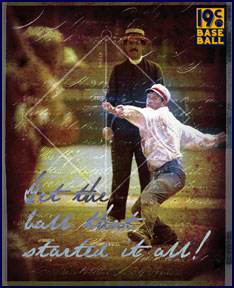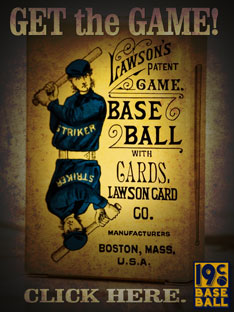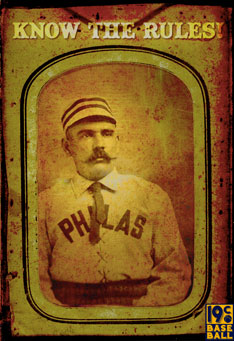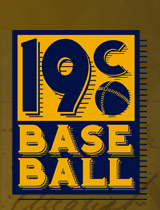The Batter's Area and Position
(Pre-1856 to 1873) Continued

he batter was allowed to call for a "high" or "low" ball beginning in 1871. A low pitch was a pitched ball that crossed home base and was between the striker's knees and his waist. A high ball was a pitched ball that crossed home base was between the striker's waist and shoulders. The batting rule for the first season of the National Association of Professional Base-Ball Players was modified for the 1871 season and was printed as follows in De Witt's:
The striker when in the act of striking at the ball, must stand astride the line of the home-base, and distant not less than one foot from the home base, and when striking at the ball he may take a forward step, provided such step does not take both his feet forward of the line of the home base. The penalty for an infringement of this rule shall be the calling of "foul strike," and when three such strikes have been called, the striker shall be declared out. If a ball on which such a strike is called be hit and caught, either fair or foul, the striker shall be declared out.
NOTE: that Beadle's Dime Base Ball Player for 1871 printed the same rule as the 1869 and 1870 editions.
The narrative for the rule in the De Witt's guide simply stated," The change in this section consists of adding a provision for taking a forward step."
As the batters started to regain a little more dominance the rule was clarified. The rule listed is very specific and even addresses the distance the batter is allowed to be from home base. Batters were using lighter bats to combat the increased changes in speed that were implemented by all pitchers. When batters identified a change-up thrown by the pitcher, or guessing a fastball was being thrown, they were lunging at the ball attempting to drive it and when they were moving forward often had their back foot past the line. This is addressed in the statement "provided such step does not take both his feet forward of the line of the home base."
Home Base was required to be made of white marble or stone for the 1872 season. A low ball now defined as being a pitched ball that crossed home base and was not lower than one foot off the ground and no higher that the batter's waist. The batter's rule was slightly changed for the 1872 season and was also used for the 1873 season. It was listed as follows in De Witt's Base Ball Guide:
The striker when in the act of striking at the ball, must stand astride the line of the home-base, and distant not less than one foot from that base, and when occupying this position only one foot must be forward or backward of the line of home base. The penalty for an infringement of this rule shall be the calling of "foul strike," and when three such strikes have been called, the striker shall be declared out. If a ball on which such a strike is called be hit and caught, either fair or foul, the striker shall be declared out.
Now the batter was required to begin by straddling the striker's line which restricted his movement while striking at a pitched ball and placed him in a more set position.
Post 1873
The 1874 season was the first season that implemented the modern day batter's box. It was six feet long, pitcher to catcher and three feet wide, set one foot from the batter's point, known as the line of home base and centered to home base so the batter's point divided the box in half. The batter was required to start and end his at bat while within these lines. He was allowed to move as much as he wanted to before during his swing as long as he remained in the box when striking the pitched ball. If the batsman swung and made contact with a pitched ball while he was outside the lines of the box, a foul strike and out was called and the ball was considered dead. The batter was also declared out if he "willfully strikes at the ball to hinder the ball from being caught."
Home Base was moved entirely into foul ground for the 1875 and 1876 seasons. The pitcher's point now rested on the spot where the third and first base foul lines met. The batter's box dimensions remained unchanged except that the batter's point now split the box so that two feet were forward of its center, the line of home base and four feet were behind the line of home base. Starting in 1876, the striker had three minutes to take his position after being called for by the umpire before being called out.
For the start of the 1877 season home base was moved entirely into fair ground and would remain in fair ground for the rest of the 19th century. It was placed so that two sides of the Home Base would lie on top of the third and first base foul lines and the catcher's point would be on top of the intersection of those lines. As per the amateur rules listed in De Witt's Base Ball Guide for 1877, home base was allowed to be wood, iron or stone that was whitened. The batter's box size remained unchanged and it was place in the same position as it originally started in 1874. The striker now only had one minutes to take his position after being called for by the umpire before being called out.
During the Union Association's only season in 1884, they also instituted the same position and composition of home base and followed the same batter's area dimensions as the National League and the American Association.
The National League increased the size of the batter's area to 6 feet by 4 feet and moved the entire box to within six inches of the batter's point, for the 1885 season. The American Association did the same for their 1886 season. There would be no further changes to the batter's area for the rest of the 19th century and the batter's box today is the same size and placed in the same position as it was originally placed in the NL in 1885.
The American Association first went to an all rubber home base, white, in 1885 and the National League stipulated that home base could be made of either white rubber or white stone. In 1886, the AA changed the composition of home base to allow for either white stone, iron or rubber. When the two leagues agreed to use the same playing rules for the 1887 season home base was required to be of "whitened" rubber. The Players' National League of Base Ball Clubs also used a white rubber home base for their only season in 1890.
Home base's makeup would not change for the remainder of the 19th century and is still made of white rubber today.




